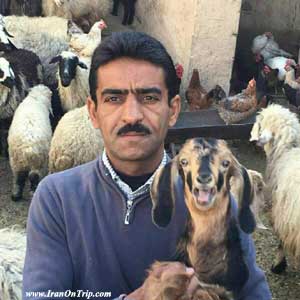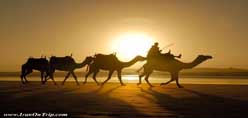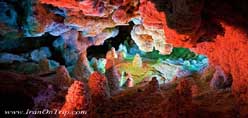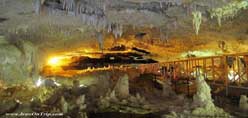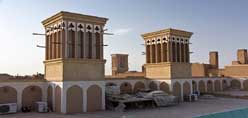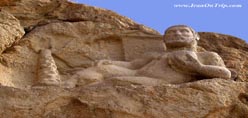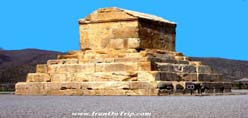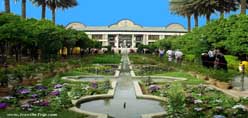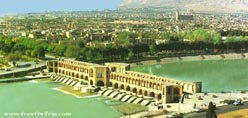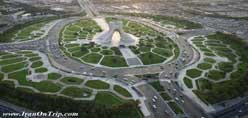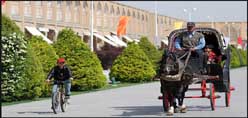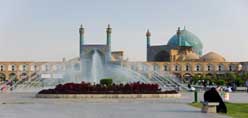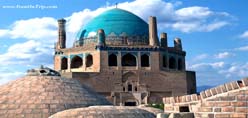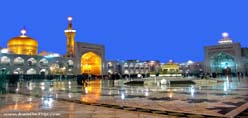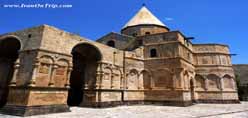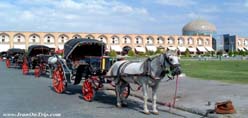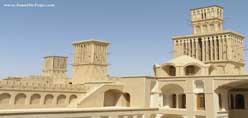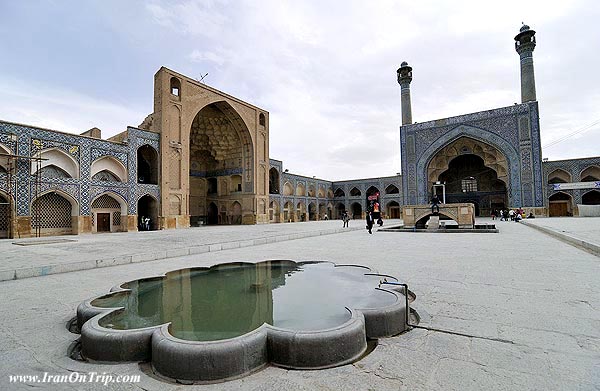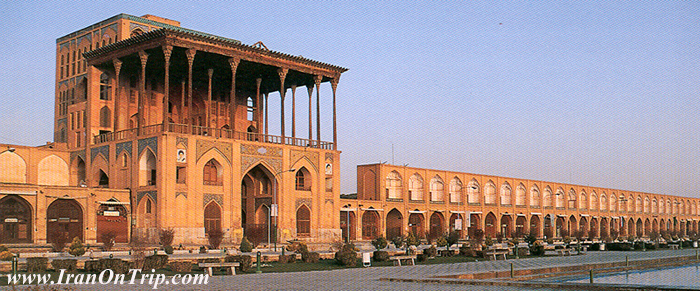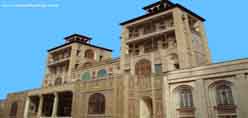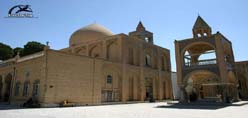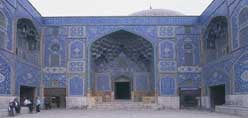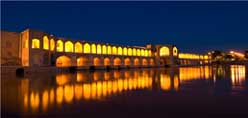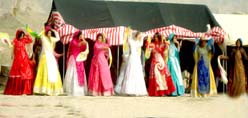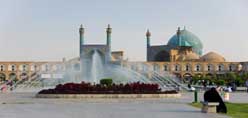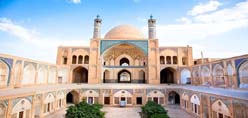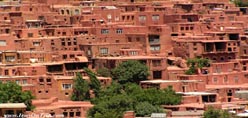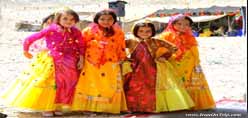Zorkhaneh
Abstract:
The Zoorkhaneh is a place to gain strength, reinforce the virtues of sportsmanship, modesty,
humbleness and avoid arrogance. Zoorkhaneh sports are done in a roofed area; the building
resembles ancient temples or cellars. The entrance is smaller than usual doors. The rood is high
and domed, like a mosque. The Gowd, the hollow, deeper area in the middle of the Zoorkhaneh,
is where the sports are done. The Zoorkhaneh being a sacred place, there only the chest, pure,
modest, the morally and bodily clean men; and those men who are free from evil thoughts come
together.
Key words: Zoorkhaneh, Traditional, Sport, Iran.
Introduction: Thousands years old, most ancient sport of Iran-Zoorkhaneh which was earlier
known as Zoorkhanoon, it is a Persian type of sports club where athletes under go a rigorous
regiment training under the direction of tested masters known Morshed, on the other hand it was
known in the ancient Iranian society “the place where Iranian men participated to be closer to
God, but modern age is fading it up (Ghosh, 2005).
The promotion and evolution that appeared in all aspect of the life of the Iranian life also
embraced sports and physical education, thereby many of the sports philosophies or even the
sports activities assumed holy images and spiritual forms. Sports and in the wake of it sport clubs
and stadiums become much more active than the past but with the objective of being in the
service of the oppressed and struggling against the oppressed through which a higher growth
development. In this connection Zoorkhaneh that in its unique form had weak roots among pre-
Islamic Iranian in the post- Islamic era as clubs and stadiums of today, aiming at training
gentlemen heroes and real Muslims become more active and underwent much quantities and
qualities evolution (Bahram, 1995). Any behavior contradicting these principles is strongly
disapproved. The Zoorkhaneh eating, standing joke and smoking is not allowed. Nor a person’s
social position and high rank and reputation is taken into account in Zoorkhaneh. Only the rank
and standing of a Pish Kesvat (leader) and the seniority of the athletes is always taken into
consideration, accounted and held in high reverence (Kazemaini & Samuel, 1964).
This volume is a brief account of Zoorkhaneh as the most sacred and ancient sports places in the
history of man the glory for the establishment of which is uniquely that of Iranians and
particularly the Islamic culture. It is not many places in the world where one can see this sport at
close quarter.
2
General appearance and essential facilities
Usually the Zoorkhaneh are built in back alleys away from general view. Its outside appearance
is a square building with a dome, hollow, which was for one of the spectacular activities of the
zoorkhaneh jugging (MILBAZI) also for the suitable vibration of the echo of the Morshed’s
drum. Usually in the ceiling light traps are inserted. It should be noted that in the past sport
activities in Zoorkhaneh was carried out at the crack of dawn but, unfortunately, the habit of
early morning rising has subsided and the sports activities are carried out at sunset and in the
evening.
Entrance door: The entrance door is low so that body of any walk of life at the time of entrance
must of necessity bow in respect and enters this sacred place.
SARDAM: Sardam is constructed adjacent to the entrance door and it is a place for Morshed to
sit it. It overlooks the GOWD with a height of one meter or less. Sardam was carpeted with a
skin rug and a brazier with charcoal fire was placed nearby to warm the skin of the drum.
(Bahram, 1995)
Bell (ZANG): Zang is a cymbal made of brass. In the Zoorkhaneh it is played by
the Morshed who beats it with his hands in order to convey a rhythm or movement
change. It is also sounded at the entry of honored guests as way to show respect.
Drum (ZARB): Played with hands, Zarbe-e-Zoorkhaneh is a large goblet-shaped drum made
from clay and covered with goatskin. It is played with hands. Through his playing,
the drummer provides the guiding rhythm for the sequences practiced in the
ancient Iranian martial arts, called Varzesh-e-Bastaani (Sport of the Ancients). In
the Zoorkhaneh, where the movements are practiced, only the specifically trained
Morshed or guide can play the drum (Beizai, 1967).
SOFFEH or GHORFEH: This is the place where the spectators sit and is usually square or
rectangular in shape and overlooks the GOWD as ZARB ARCH. Sometimes a number of these
GHORFEHS were allocated to dressing rooms of the sportsmen.
3
GOWD: Is the most essential part of Zoorkhaneh and is the stage for performance of
Zoorkhaneh activities. As opposed to the sitting place of the spectators GOWD is on a lower
level which in itself denotes the courtesy and politeness of the sports people. The shape of
GOWD is constructed in a hexagonal or octagonal shape. In former days the floor was covered
by dried bushes covered with soft earth to prevent injury to the sportsmen but nowadays the floor
is prepared according to other indoor sports hall. The GOWD is in high fever. Every muscle in
the body of each of all the athletes, while exercising, is outstandingly moving (Kazemaini &
Samuel 1964).
MORSHED: A person inside Zoorkhaneh who
chants historic stories especially from
Shahnameh (The Book of Kings). Morshed
literally means one who guides. In Zoorkhaneh,
he plays the drum and conducts the rhythmic
music. All Pahlavani-championship-exercises are
synchronized with Morshed's drum, both
individually and in group exercises where group
coordination is needed.
4
MIANDAR (MID- CONDUCTOR): During the performance the participants from a circle and
it is needed for the conduct of the affairs on of the skilled and experienced sportsmen to stand in
the middle of the ring and to give direction and determine the type of action as fits the some total
of all participants proportionately and coordinate it with Morshed. This person is entitled
MIANDAR.
Activities and Instruments of Zoorkhaneh
SANG AND SANG GIRI (Stone lifting): Sang is a symbol of shield in Zoorkhaneh. It
comprises two rectangular wooden pieces which is semi-circled at the middle a hand hold is cut.
SANG GIRI is one of the most difficult of the Zoorkhaneh activities and is the first item. The
participants lift the stone while lying prostrate on the ground and
during the exercise he should not let the stones touch the ground nor
shall he rest. In this exercise different forms such as twisting the body
etc are carried out and are not easy for many people to do.
Press board and hand press: The hand press board is a wooden piece 120 centimeters Long, 9-
10 centimeters Wide over the ground is no more than few centimeters. The hand press activity in
Zoorkhaneh is to strengthen the arms and shoulders and is also a symbol of falling down to earth
in front of God in adoration. The participants now thrust themselves over the arm; now they poke
the arms under their breasts; now violently they shot their legs straight out to the edge of the
Gowd; now they convulsively coil them up; now they shot out their twisted bodies, change them
to same straight bridges; now they fiercely double in two; now they thrust themselves over the
Takhteh Shena- The hand press board- and they resort to every sort of callisthenic action.
5
KHAM GIRI: This is an exercise in which squatting and rising and twisting the members and
body for warming up and loosening the joints. It can be done with no instrument or with mil
(described later). These actions that follow hand press are for relaxation and to let blood run
again into the lower members and prepare the participants for the next stage.
MIL, MILVARZI AND MILBAZI: This is the second and one of the thrilling
rounds ever displayed in the Zoorkhaneh. Mil is an instrument shaped like mass.
It is wooden and conical with a handle at the top. Usually they weigh 10-30
Kilograms. But heavier Mils in Zoorkhaneh denote more powerful sportsmen
which bring credit. There is smaller variety of Mil with longer handle weighing
4 Kilograms. Or less which are used in MILBAZI (juggling). In these activities
the participant throws the MILS in the air at
short and high heights and recaptures them.
There are many forms and skills in this
action in which the participant shows his
skill in many ways and amuses the
spectators and participants alike. This
exercise is done with 4 mils or more.
6
MILVARZI on the other hand is a unique exercise of Zoorkhaneh in which the action is to
strengthen the upper part of the body. There are several forms for this also and is carried out with
a special rhythm.
MILVARZI is always done with a pair of
Mils which are selected according to the
strength of the individual using them.
CHARKH: (Turn and Twist): In this
action the participant opens his arms along
the shoulder line and then with special
rhythms’ and varying speeds he changes his
feet round him and encircles the GOWD.
CHARKH is an exercise of Zoorkhaneh
that require great skill for performance
(Bahram, 1995). This a simple Charkh
exercise. But, the speed of this rotator
movement surpasses and conceivable limit
to a height that it makes the spinning athlete
assume the shape of a spinning top. At this juncture of time the athletes head, arms, body and
feet seem to have been poured into the mould of a single top. This act of spinning is one of the
refinements -Shirinkary- and it marks one of the finest features of the ancient exquisite exercises
of Iran. While spinning, the embellishments of leaps and falls in which the Charkh athlete turns
his lead over heels in the air are seasoned with some other refinement (Kazemaini & Samuel
1964).
KABBADEH AND KABBADEH GEREFTAN: The Kabbadeh is a bow
made of iron with metal rings and coin-like pieces hanging on its body. The
athlete should lift it above his head and move it over his head and shoulders
so that his hands do not bend; meanwhile, the Morshed counts and beats his
drum. The Kabbadehs available in the Zoorkhaneh usually come in
different weights. The Three Forms of Kabbadeh Zadan (Kabbadeh
Workouts):
7
1. One-sided: The Kabbadehs are moved back and forth between one of the shoulders to the head.
2. Two-sided: Here, the Kabbadeh is moved from the left shoulder to the right; usually, only
veterans and champions can do this move.
3. Facing the chest or front: In this difficult move, the
Kabbadeh is pulled vertically by opening the hands
toward both sides of the body.
Traditionally, the Kabbadeh workout begins with the
youngest athletes to the eldest. The Morshed gives the
younger athletes a drum beat and the older ones epic
poetry to accompany their workout. The Morshed’s
count goes up to fifty; like the Sang workout, when the
athlete reaches the count of 50, the Morshed starts
counting back to 1. In youth competitions, the
Kabbadeh should weigh 18 kilograms; in adult bouts,
the weight is 20 kilograms (Hosseini, 2005).
Conclusion:
Iranians were one of the first nations in the world who gave a great deal of attention to their
health, burly figure and strength. Zoorkhaneh is the Iranian traditional gymnasium. The aim of
Zoorkhaneh was and is not only to produce athletes but to provide physical and spiritual training.
Characteristic of Zoorkhaneh is attractive to young persons as it requires not only strong body
but also the skills that youth enjoy. Most of the Olympic sports of today were once in the same
stage as Zoorkhaneh and with some modifications to the rules and equipment they grew popular
internationally. In short, Zoorkhaneh has the potential to be an internationally recognized martial
arts sport and with some modifications could become competitive in stature.
Every cultural element is not only valuable locally or nationally; it enriches man’s global
treasure, and belongs to the whole of the human society. Although the avalanche of Western
cultural elements has made many cultural elements fade away, the zoorkhaneh is still going
strong. It shines like a pearl that has crystallized through thousands of years of our culture. It is
our duty to be deserving successors, and safeguard our cultural heritage and spiritual capital and
try to make it even richer rather than let it fade away or be destroyed. Losing it would not only
our loss; a part of man’s whole culture will have been lost. Zoorkhaneh is still one of the living
8
things we have inherited from our ancestors; it continues to contribute significantly to Iranian life.
Zoorkhaneh can still remind us about championship, fairness and dignity, and educate healthy
and proud youth for us. It is due to the uniquely constructive role of the zoorkhaneh that its
preservation and expansion – athletically and culturally as well as socially and ethically - is
extremely important.
All said and done –Zoorkhaneh is unique, the heroes were trained in the Zoorkhaneh, the place
where tradition and sports mingled, the place where Rustam, Purya-ye Vali and Thakti trained.
The aim of Zoorkhaneh was and is not only to produce athletes but to provide physical &
spiritual training.
The idea of reviving the old traditional sports very widely discussed but the old heroes hardly
visit the remaining zoorkhaneh, which has to be back.
Although the nature of heroism still remains in the core of Iranian hearts, but will they really be
revived again and will bell’s sound in the towns of Iran and at its extension.
The Zoorkhaneh is a place to gain strength, reinforce the virtues of sportsmanship, modesty,
humbleness and avoid arrogance. Zoorkhaneh sports are done in a roofed area; the building
resembles ancient temples or cellars. The entrance is smaller than usual doors. The rood is high
and domed, like a mosque. The Gowd, the hollow, deeper area in the middle of the Zoorkhaneh,
is where the sports are done. The Zoorkhaneh being a sacred place, there only the chest, pure,
modest, the morally and bodily clean men; and those men who are free from evil thoughts come
together.
Key words: Zoorkhaneh, Traditional, Sport, Iran.
Introduction: Thousands years old, most ancient sport of Iran-Zoorkhaneh which was earlier
known as Zoorkhanoon, it is a Persian type of sports club where athletes under go a rigorous
regiment training under the direction of tested masters known Morshed, on the other hand it was
known in the ancient Iranian society “the place where Iranian men participated to be closer to
God, but modern age is fading it up (Ghosh, 2005).
The promotion and evolution that appeared in all aspect of the life of the Iranian life also
embraced sports and physical education, thereby many of the sports philosophies or even the
sports activities assumed holy images and spiritual forms. Sports and in the wake of it sport clubs
and stadiums become much more active than the past but with the objective of being in the
service of the oppressed and struggling against the oppressed through which a higher growth
development. In this connection Zoorkhaneh that in its unique form had weak roots among pre-
Islamic Iranian in the post- Islamic era as clubs and stadiums of today, aiming at training
gentlemen heroes and real Muslims become more active and underwent much quantities and
qualities evolution (Bahram, 1995). Any behavior contradicting these principles is strongly
disapproved. The Zoorkhaneh eating, standing joke and smoking is not allowed. Nor a person’s
social position and high rank and reputation is taken into account in Zoorkhaneh. Only the rank
and standing of a Pish Kesvat (leader) and the seniority of the athletes is always taken into
consideration, accounted and held in high reverence (Kazemaini & Samuel, 1964).
This volume is a brief account of Zoorkhaneh as the most sacred and ancient sports places in the
history of man the glory for the establishment of which is uniquely that of Iranians and
particularly the Islamic culture. It is not many places in the world where one can see this sport at
close quarter.
2
General appearance and essential facilities
Usually the Zoorkhaneh are built in back alleys away from general view. Its outside appearance
is a square building with a dome, hollow, which was for one of the spectacular activities of the
zoorkhaneh jugging (MILBAZI) also for the suitable vibration of the echo of the Morshed’s
drum. Usually in the ceiling light traps are inserted. It should be noted that in the past sport
activities in Zoorkhaneh was carried out at the crack of dawn but, unfortunately, the habit of
early morning rising has subsided and the sports activities are carried out at sunset and in the
evening.
Entrance door: The entrance door is low so that body of any walk of life at the time of entrance
must of necessity bow in respect and enters this sacred place.
SARDAM: Sardam is constructed adjacent to the entrance door and it is a place for Morshed to
sit it. It overlooks the GOWD with a height of one meter or less. Sardam was carpeted with a
skin rug and a brazier with charcoal fire was placed nearby to warm the skin of the drum.
(Bahram, 1995)
Bell (ZANG): Zang is a cymbal made of brass. In the Zoorkhaneh it is played by
the Morshed who beats it with his hands in order to convey a rhythm or movement
change. It is also sounded at the entry of honored guests as way to show respect.
Drum (ZARB): Played with hands, Zarbe-e-Zoorkhaneh is a large goblet-shaped drum made
from clay and covered with goatskin. It is played with hands. Through his playing,
the drummer provides the guiding rhythm for the sequences practiced in the
ancient Iranian martial arts, called Varzesh-e-Bastaani (Sport of the Ancients). In
the Zoorkhaneh, where the movements are practiced, only the specifically trained
Morshed or guide can play the drum (Beizai, 1967).
SOFFEH or GHORFEH: This is the place where the spectators sit and is usually square or
rectangular in shape and overlooks the GOWD as ZARB ARCH. Sometimes a number of these
GHORFEHS were allocated to dressing rooms of the sportsmen.
3
GOWD: Is the most essential part of Zoorkhaneh and is the stage for performance of
Zoorkhaneh activities. As opposed to the sitting place of the spectators GOWD is on a lower
level which in itself denotes the courtesy and politeness of the sports people. The shape of
GOWD is constructed in a hexagonal or octagonal shape. In former days the floor was covered
by dried bushes covered with soft earth to prevent injury to the sportsmen but nowadays the floor
is prepared according to other indoor sports hall. The GOWD is in high fever. Every muscle in
the body of each of all the athletes, while exercising, is outstandingly moving (Kazemaini &
Samuel 1964).
MORSHED: A person inside Zoorkhaneh who
chants historic stories especially from
Shahnameh (The Book of Kings). Morshed
literally means one who guides. In Zoorkhaneh,
he plays the drum and conducts the rhythmic
music. All Pahlavani-championship-exercises are
synchronized with Morshed's drum, both
individually and in group exercises where group
coordination is needed.
4
MIANDAR (MID- CONDUCTOR): During the performance the participants from a circle and
it is needed for the conduct of the affairs on of the skilled and experienced sportsmen to stand in
the middle of the ring and to give direction and determine the type of action as fits the some total
of all participants proportionately and coordinate it with Morshed. This person is entitled
MIANDAR.
Activities and Instruments of Zoorkhaneh
SANG AND SANG GIRI (Stone lifting): Sang is a symbol of shield in Zoorkhaneh. It
comprises two rectangular wooden pieces which is semi-circled at the middle a hand hold is cut.
SANG GIRI is one of the most difficult of the Zoorkhaneh activities and is the first item. The
participants lift the stone while lying prostrate on the ground and
during the exercise he should not let the stones touch the ground nor
shall he rest. In this exercise different forms such as twisting the body
etc are carried out and are not easy for many people to do.
Press board and hand press: The hand press board is a wooden piece 120 centimeters Long, 9-
10 centimeters Wide over the ground is no more than few centimeters. The hand press activity in
Zoorkhaneh is to strengthen the arms and shoulders and is also a symbol of falling down to earth
in front of God in adoration. The participants now thrust themselves over the arm; now they poke
the arms under their breasts; now violently they shot their legs straight out to the edge of the
Gowd; now they convulsively coil them up; now they shot out their twisted bodies, change them
to same straight bridges; now they fiercely double in two; now they thrust themselves over the
Takhteh Shena- The hand press board- and they resort to every sort of callisthenic action.
5
KHAM GIRI: This is an exercise in which squatting and rising and twisting the members and
body for warming up and loosening the joints. It can be done with no instrument or with mil
(described later). These actions that follow hand press are for relaxation and to let blood run
again into the lower members and prepare the participants for the next stage.
MIL, MILVARZI AND MILBAZI: This is the second and one of the thrilling
rounds ever displayed in the Zoorkhaneh. Mil is an instrument shaped like mass.
It is wooden and conical with a handle at the top. Usually they weigh 10-30
Kilograms. But heavier Mils in Zoorkhaneh denote more powerful sportsmen
which bring credit. There is smaller variety of Mil with longer handle weighing
4 Kilograms. Or less which are used in MILBAZI (juggling). In these activities
the participant throws the MILS in the air at
short and high heights and recaptures them.
There are many forms and skills in this
action in which the participant shows his
skill in many ways and amuses the
spectators and participants alike. This
exercise is done with 4 mils or more.
6
MILVARZI on the other hand is a unique exercise of Zoorkhaneh in which the action is to
strengthen the upper part of the body. There are several forms for this also and is carried out with
a special rhythm.
MILVARZI is always done with a pair of
Mils which are selected according to the
strength of the individual using them.
CHARKH: (Turn and Twist): In this
action the participant opens his arms along
the shoulder line and then with special
rhythms’ and varying speeds he changes his
feet round him and encircles the GOWD.
CHARKH is an exercise of Zoorkhaneh
that require great skill for performance
(Bahram, 1995). This a simple Charkh
exercise. But, the speed of this rotator
movement surpasses and conceivable limit
to a height that it makes the spinning athlete
assume the shape of a spinning top. At this juncture of time the athletes head, arms, body and
feet seem to have been poured into the mould of a single top. This act of spinning is one of the
refinements -Shirinkary- and it marks one of the finest features of the ancient exquisite exercises
of Iran. While spinning, the embellishments of leaps and falls in which the Charkh athlete turns
his lead over heels in the air are seasoned with some other refinement (Kazemaini & Samuel
1964).
KABBADEH AND KABBADEH GEREFTAN: The Kabbadeh is a bow
made of iron with metal rings and coin-like pieces hanging on its body. The
athlete should lift it above his head and move it over his head and shoulders
so that his hands do not bend; meanwhile, the Morshed counts and beats his
drum. The Kabbadehs available in the Zoorkhaneh usually come in
different weights. The Three Forms of Kabbadeh Zadan (Kabbadeh
Workouts):
7
1. One-sided: The Kabbadehs are moved back and forth between one of the shoulders to the head.
2. Two-sided: Here, the Kabbadeh is moved from the left shoulder to the right; usually, only
veterans and champions can do this move.
3. Facing the chest or front: In this difficult move, the
Kabbadeh is pulled vertically by opening the hands
toward both sides of the body.
Traditionally, the Kabbadeh workout begins with the
youngest athletes to the eldest. The Morshed gives the
younger athletes a drum beat and the older ones epic
poetry to accompany their workout. The Morshed’s
count goes up to fifty; like the Sang workout, when the
athlete reaches the count of 50, the Morshed starts
counting back to 1. In youth competitions, the
Kabbadeh should weigh 18 kilograms; in adult bouts,
the weight is 20 kilograms (Hosseini, 2005).
Conclusion:
Iranians were one of the first nations in the world who gave a great deal of attention to their
health, burly figure and strength. Zoorkhaneh is the Iranian traditional gymnasium. The aim of
Zoorkhaneh was and is not only to produce athletes but to provide physical and spiritual training.
Characteristic of Zoorkhaneh is attractive to young persons as it requires not only strong body
but also the skills that youth enjoy. Most of the Olympic sports of today were once in the same
stage as Zoorkhaneh and with some modifications to the rules and equipment they grew popular
internationally. In short, Zoorkhaneh has the potential to be an internationally recognized martial
arts sport and with some modifications could become competitive in stature.
Every cultural element is not only valuable locally or nationally; it enriches man’s global
treasure, and belongs to the whole of the human society. Although the avalanche of Western
cultural elements has made many cultural elements fade away, the zoorkhaneh is still going
strong. It shines like a pearl that has crystallized through thousands of years of our culture. It is
our duty to be deserving successors, and safeguard our cultural heritage and spiritual capital and
try to make it even richer rather than let it fade away or be destroyed. Losing it would not only
our loss; a part of man’s whole culture will have been lost. Zoorkhaneh is still one of the living
8
things we have inherited from our ancestors; it continues to contribute significantly to Iranian life.
Zoorkhaneh can still remind us about championship, fairness and dignity, and educate healthy
and proud youth for us. It is due to the uniquely constructive role of the zoorkhaneh that its
preservation and expansion – athletically and culturally as well as socially and ethically - is
extremely important.
All said and done –Zoorkhaneh is unique, the heroes were trained in the Zoorkhaneh, the place
where tradition and sports mingled, the place where Rustam, Purya-ye Vali and Thakti trained.
The aim of Zoorkhaneh was and is not only to produce athletes but to provide physical &
spiritual training.
The idea of reviving the old traditional sports very widely discussed but the old heroes hardly
visit the remaining zoorkhaneh, which has to be back.
Although the nature of heroism still remains in the core of Iranian hearts, but will they really be
revived again and will bell’s sound in the towns of Iran and at its extension.
.....
.....
.....

.jpg)
